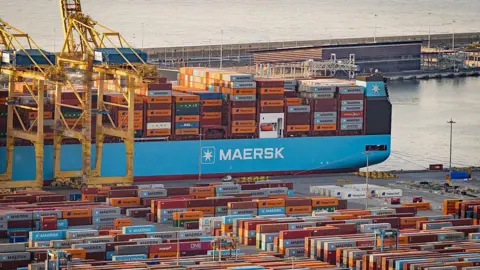The recently concluded trade deal between the United States and the European Union (EU) reflects a significant moment in international relations, marking an essential pivot in the dynamics of global trade. Following intense negotiations between key trade officials, the agreement came to fruition just prior to a new round of tariff discussions involving the U.S. and China. This development marks an advancement in the long-standing economic partnership, yet both sides appear to extract varied triumphs from the outcome.
The agreement was reached after crucial face-to-face interactions among top leaders from Washington and Brussels. This personal involvement has been a recurring theme in President Donald Trump’s recent negotiations; it arguably contributed to tipping points in several significant trade discussions, even amidst a seemingly bleak outlook in prior talks. The necessity of this trade agreement stems from the intricate web of businesses and jobs that rely on what the EU titles as “the world’s largest bilateral trade and investment relationship.”
Both President Trump and European Commission President Ursula von der Leyen could rightfully present the pact as a victory for their respective administrations. For Europe, the tariffs implemented could have been more severe than the 15% eventually agreed upon, especially when considered against the backdrop of a hefty 30% tax that had been foreseen. Additionally, this figure is notably less favorable than the 10% rate set by the United Kingdom.
For the United States, the deal signifies anticipated tariff revenue, estimated to hover around $90 billion based on last year’s trade statistics, alongside a promise of $600 billion in new investments flowing into the country. Yet, the specifics regarding the timing and areas of these investments remain shrouded in uncertainty. As such, while the agreement is touted as landmark, its true implications will depend significantly on the detailed execution that follows.
The path to this agreement has certainly been challenging, with both parties engaging in tough negotiations and showing a reluctance to yield ground easily. Urgent deadlines, such as the looming August 1 deadline, maintained momentum, as both sides appeared eager to avoid prolonging discussions that might lead to further economic uncertainty. The backdrop of an escalating trade deficit—wherein the United States imported $236 billion more from the EU than it exported—underscored the urgency for an arrangement. President Trump has often characterized this scenario as a loss of American wealth, although the reality of global trade presents a far more complex landscape.
The agreement also addressed tensions regarding stringent EU regulations that have obscured American companies’ ability to access EU markets. Details on whether these regulatory impediments will be ameliorated alongside this new deal remain scant. However, President von der Leyen has acknowledged the need for rebalancing trade dynamics, noting the substantial volume of trade between the two parties and the necessity of making it sustainable.
This recent development has become part of a larger narrative where President Trump demonstrates a vigorous approach to reshaping American trade agreements. Following this deal with the EU, the U.S. has also secured agreements with other countries including Japan, Vietnam, and Indonesia, with significant trade negotiations pending with Canada, Mexico, and China.
As the U.S. gears up for further talks with China in Stockholm, Sweden, there’s anticipation that tariffs may be postponed for an additional 90 days. President Trump has mentioned positive relations with China, hinting at potential resolutions. However, the stance China has taken throughout negotiations has been much firmer than those of other trade entities, suggesting that complexities could still hinder future discussions.
In conclusion, while both the U.S. and the EU can celebrate what they perceive as a mutually beneficial agreement, the real measure of success will hinge on the particulars of implementation and how these negotiations affect the broader global economy in the months to come. The unfolding narrative will continue to evolve as countries navigate through the burgeoning complexities of international trade relations in a globalized world.












